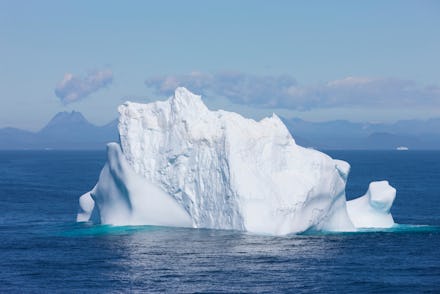A chunk of iceberg the size of London has broken off of Antarctica

A massive chunk of ice, an iceberg about the size of London has separated from the Amery ice shelf in east Antarctica. Nicknamed D-28 by researchers and monitors, the enormous chunk of ice separated on or around September 26. It's a whopping 1,636 square kilometers in size, which translates to about 931 miles, according to the Australian Antarctic Division. To clarify its massive size even further, that's about 315 billion tons, BBC News points out.
The city-sized block of ice will now be floating around aimlessly in the ocean, which could potentially pose a hazard to shipping routes throughout the area, and given its size, it's not as if you could just melt the berg and get rid of it. It's the biggest iceberg calved from thee Amery ice shelf since the 1960s, which was a comparative 9,000 sq km in size after calving.
Ice calving is the expression for what occurs when ice chunks break off from the edge of a glacier, marked by a "sudden release" or breaking away, which is exactly what happened here. It's a very common phenomenon.
The Amery shelf is the third largest iceberg in Antarctica, and as such is part of an important drainage channel for the entire easternmost side of the the continent. At the very least, this massive chunk of ice being separated into the sea wasn't a surprising or isolated incident. Scientists are well aware that glaciers end up calving like this and flowing into the ocean all the time. It's part of a vital process that helps ice streams reach and maintain balance.
And it's important to note that this time, climate change isn't really to blame, according to professor Helen Fricker, from the Scripps Institution of Oceanography, speaking to BBC News.
"While there is much to be concerned about in Antarctica, there is no cause for alarm yet for this particular ice shelf," she said. In terms of the Amery Ice Shelf, the entire body was known as "Loose Tooth" because of the way it resembles a small child's tooth, and as such scientists have been waiting for a piece to break away. However, Fricker had predicted that it would occur between 2010 and 2015. It looks like D28 is just a little late, that's all. The piece that broke off, she predicted, was going to be in a different area and a lot smaller than the size of an entire city, too.
"It is like expecting a baby tooth to come out, and instead out comes a molar," said Fricker of the incident.
Luckily, the iceberg calving won't end up affecting the sea level, because the main iceberg had already been floating, "much like an ice cube in a glass of water," glaciologist Ben Galton-Fenzi told The Guardian. However, its loss could end up changing the speed ice flows off the continent in the future.
"What will be interesting to see is how the loss of this ice will influence the ocean melting under the remaining ice shelf and the speed at which the ice flows off the continent." Luckily, the iceberg calving won't end up affecting the sea level, because the main iceberg had already been floating.
Right now it doesn't look like there's any cause for alarm, just time to marvel and awe about this absolutely huge chunk of ice just hanging out in the water. Our world sure does work in amazing ways.